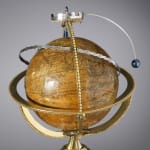Augustin II Fortin
Literature
Pierre Kjellberg, "Encyclopédie de la Pendule Française du Moyen Age au XXe Siècle", 1997, p. 188, pl. A, illustrating another Louis XVI gilt bronze mounted planetarium clock by Augustin II Fortin of 1770 which was given by Louis XVI to Monsieur de Montillet, avocat général au Grand Conseil du roi, featuring a very similar rotating terrestrial globe and astronomical indications mounted on a fluted column on a square plinth with clock dial flanked by lion head masks on lion paw feet.
A rare Louis XVI gilt bronze white marble planetarium clock by Augustin II Fortin of eight day duration surmounted by a rotating terrestrial globe inscribed on a plaque on the globe Chez le Sieur Fortin Ingenuera Pour Les Globes et Spheres Rue de la Harpe au Coin de la Rue du Foin, and further inscribed on a silver plaque attached to the globe Paris, having a golden sun and long pointer to indicate sunrise and sunset in Paris, the globe surmounted by a rotating silver lunar ring inscribed with Arabic numerals 1-29 ½ for the lunar days in the month and Nouvelle Lune/ Dm Quartier/ Pleine Lune, issuing a small blue moon sphere suspended from a silvered band, with a shaped silver hour chapter ring around the globe marked twice 1-12, the arched brass ring around the globe engraved Sud/Zenith/Nord as well as engraved on both sides between the south and zenith markings Medi pour tous les peuples qui sont de sous ce meridian and further engraved with the symbols of the seven days of the week as well as the numbers 21/23/18/20/21/21, the horizontal brass ring around the globe engraved Oriente Leve du Soleil and Occident Couche du Soleil.
The globe on a gilt bronze mounted white marble plinth centred by a circular white enamel clock dial with black Arabic numerals for the hours, outer red Arabic numerals for the minutes and inner red Arabic numerals for the 31 days of the month with a fine pair of pierced gilt brass hands for the hours and minutes and blued steel pointer for the calendar indications. The movement with striking on the hour and half hour and with independent powering to the axel for the rotation of the globe. The fluted plinth case of ovoid columnar form with scrolled sides on a shaped stepped base with pierced foliate frieze on turned feet
Paris, date circa 1770
Height 53 cm, width 28 cm, depth 14 cm.
The maker of this magnificent work was Augustin II Fortin (d. 1784), who descended from a family of clock and watchmakers and was himself a master clockmaker, renowned for his astronomical clocks, armillary spheres as well as his celestial and terrestrial globes. As evidence of his prowess in this latter field Fortin often signed his work as ingénieur or as here ingenuera for globes and spheres. Augustin II came from a long line of clockmakers all of whom worked in Paris at rue de la Harpe, firstly his great grandfather Nicolas (d. after 1727), then his grandfather Augustin I (d. 1778), followed by his father Michel (1726-80). Having been received as a maître in June 1769 Augustin II firstly worked independently at rue du Petit-Lion, he then went into associated with his father and subsequently took over the family business at rue de la Harpe in 1778. Such were his talents that Fortin enjoyed the patronage of the king as well as other collectors and connoisseurs of science, astronomy and clocks.
A number of examples of his and his firm's work can be found today in the Musée des Arts et Métiers Paris at the National Maritime Museum London and at the Walters Art Gallery Baltimore. The Musée des Arts et Métiers houses for instance a planetarium, a celestial globe, three terrestrial globes one of which is also known as a tellurium or loxocosme - which demonstrates the movement of the earth, the seasons and the unequal days.



